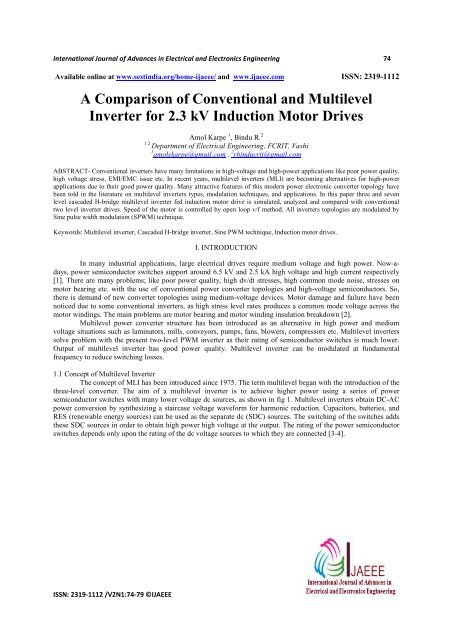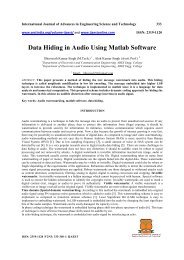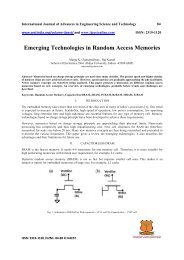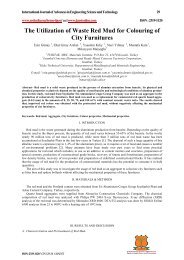A Comparison of Conventional and Multilevel Inverter for 2.3 kV ...
A Comparison of Conventional and Multilevel Inverter for 2.3 kV ...
A Comparison of Conventional and Multilevel Inverter for 2.3 kV ...
You also want an ePaper? Increase the reach of your titles
YUMPU automatically turns print PDFs into web optimized ePapers that Google loves.
International Journal <strong>of</strong> Advances in Electrical <strong>and</strong> Electronics Engineering 74<br />
Available online at www.sestindia.org/home-ijaeee/ <strong>and</strong> www.ijaeee.com ISSN: 2319-1112<br />
A <strong>Comparison</strong> <strong>of</strong> <strong>Conventional</strong> <strong>and</strong> <strong>Multilevel</strong><br />
<strong>Inverter</strong> <strong>for</strong> <strong>2.3</strong> <strong>kV</strong> Induction Motor Drives<br />
ISSN: 2319-1112 /V2N1:74-79 ©IJAEEE<br />
Amol Karpe 1 , Bindu R. 2<br />
1 2 Department <strong>of</strong> Electrical Engineering, FCRIT, Vashi<br />
1 amolskarpe@gmail.com , 2 rbinducrit@gmail.com<br />
ABSTRACT- <strong>Conventional</strong> inverters have many limitations in high-voltage <strong>and</strong> high-power applications like poor power quality,<br />
high voltage stress, EMI/EMC issue etc. In recent years, multilevel inverters (MLI) are becoming alternatives <strong>for</strong> high-power<br />
applications due to their good power quality. Many attractive features <strong>of</strong> this modern power electronic converter topology have<br />
been told in the literature on multilevel inverters types, modulation techniques, <strong>and</strong> applications. In this paper three <strong>and</strong> seven<br />
level cascaded H-bridge multilevel inverter fed induction motor drive is simulated, analyzed <strong>and</strong> compared with conventional<br />
two level inverter drives. Speed <strong>of</strong> the motor is controlled by open loop v/f method. All inverters topologies are modulated by<br />
Sine pulse width modulation (SPWM) technique.<br />
Keywords: <strong>Multilevel</strong> inverter, Cascaded H-bridge inverter, Sine PWM technique, Induction motor drives.<br />
I. INTRODUCTION<br />
In many industrial applications, large electrical drives require medium voltage <strong>and</strong> high power. Now-adays,<br />
power semiconductor switches support around 6.5 <strong>kV</strong> <strong>and</strong> 2.5 kA high voltage <strong>and</strong> high current respectively<br />
[1]. There are many problems; like poor power quality, high dv/dt stresses, high common mode noise, stresses on<br />
motor bearing etc. with the use <strong>of</strong> conventional power converter topologies <strong>and</strong> high-voltage semiconductors. So,<br />
there is dem<strong>and</strong> <strong>of</strong> new converter topologies using medium-voltage devices. Motor damage <strong>and</strong> failure have been<br />
noticed due to some conventional inverters, as high stress level rates produces a common mode voltage across the<br />
motor windings. The main problems are motor bearing <strong>and</strong> motor winding insulation breakdown [2].<br />
<strong>Multilevel</strong> power converter structure has been introduced as an alternative in high power <strong>and</strong> medium<br />
voltage situations such as laminators, mills, conveyors, pumps, fans, blowers, compressors etc. <strong>Multilevel</strong> inverters<br />
solve problem with the present two-level PWM inverter as their rating <strong>of</strong> semiconductor switches is much lower.<br />
Output <strong>of</strong> multilevel inverter has good power quality. <strong>Multilevel</strong> inverter can be modulated at fundamental<br />
frequency to reduce switching losses.<br />
1.1 Concept <strong>of</strong> <strong>Multilevel</strong> <strong>Inverter</strong><br />
The concept <strong>of</strong> MLI has been introduced since 1975. The term multilevel began with the introduction <strong>of</strong> the<br />
three-level converter. The aim <strong>of</strong> a multilevel inverter is to achieve higher power using a series <strong>of</strong> power<br />
semiconductor switches with many lower voltage dc sources, as shown in fig 1. <strong>Multilevel</strong> inverters obtain DC-AC<br />
power conversion by synthesizing a staircase voltage wave<strong>for</strong>m <strong>for</strong> harmonic reduction. Capacitors, batteries, <strong>and</strong><br />
RES (renewable energy sources) can be used as the separate dc (SDC) sources. The switching <strong>of</strong> the switches adds<br />
these SDC sources in order to obtain high power high voltage at the output. The rating <strong>of</strong> the power semiconductor<br />
switches depends only upon the rating <strong>of</strong> the dc voltage sources to which they are connected [3-4].
A <strong>Comparison</strong> <strong>of</strong> <strong>Conventional</strong> <strong>and</strong> <strong>Multilevel</strong> <strong>Inverter</strong> <strong>for</strong> <strong>2.3</strong> <strong>kV</strong> Induction Motor Drives<br />
ISSN: 2319-1112 /V2N1:74-79 ©IJAEEE<br />
Figure 1: One phase leg <strong>of</strong> an inverter with (a) 2 levels, (b) 3 levels, <strong>and</strong>(c) n levels. [3].<br />
A multilevel converter has several advantages over a conventional two-level converter that uses high<br />
switching frequency pulse width modulation (PWM) [5-6]. The attractive features <strong>of</strong> a multilevel converter are as<br />
follows; staircase wave<strong>for</strong>m quality, small common-mode (CM) voltage, <strong>and</strong> good power quality. Among this<br />
multilevel converters also have little disadvantage. One <strong>of</strong> that is the large number <strong>of</strong> power semiconductor switches<br />
required. Although lower voltage rated switches can be utilized in a multilevel converter, each switch requires its<br />
own gate pulse generation circuit. This may lead the whole system to be more complex <strong>and</strong> more costly.<br />
1.2 Topologies <strong>of</strong> <strong>Multilevel</strong> <strong>Inverter</strong><br />
Several multilevel converter topologies have been developed <strong>and</strong> underdevelopment, among this the most<br />
important topologies <strong>of</strong> multilevel-inverter are, Diode-clamped (DDC) or Neutral Point clamped (NPC) multilevel<br />
inverter, Flying-capacitor (FC) multilevel inverter <strong>and</strong> Cascaded H-bridge (CHB) multilevel-inverter.<br />
Cascaded H-bridge has been successfully implemented <strong>for</strong> very high-power <strong>and</strong> power-quality applications<br />
up to a range <strong>of</strong> 31 MVA, due to their series expansion capability. It requires the least number <strong>of</strong> components among<br />
all multilevel converters types to achieve the same number <strong>of</strong> voltage levels. Table 1 shows the suitable cascaded Hbridge<br />
inverter level <strong>for</strong> medium voltage drives.<br />
TABLE 1 CHB inverters in medium-voltage drives [3]<br />
Level Cell per phase Output Voltage<br />
7 3 <strong>2.3</strong> <strong>kV</strong><br />
9 4 3.3 <strong>kV</strong><br />
11 5 4.16 <strong>kV</strong><br />
The NPC or DDC has advantage <strong>of</strong> back-to-back configuration <strong>for</strong> regenerative applications but<br />
experiences problem <strong>of</strong> a capacitor unbalance <strong>for</strong> certain operating conditions.<br />
The FC capacitor voltages have to be recharged at start up, near to their normal values, also called as<br />
initialization. This can be done via additional <strong>and</strong> very simple control logic <strong>of</strong> the power switches <strong>of</strong> the converter.<br />
1.3 Modulation Techniques <strong>for</strong> <strong>Multilevel</strong> <strong>Inverter</strong><br />
There are many modulation techniques <strong>for</strong> multi-level inverters. Carrier based modulation (SPWM)<br />
technique is easy <strong>and</strong> efficient. Phase-shifted multicarrier techniques <strong>for</strong> obtain multilevel output voltages are<br />
commonly used in real industrial applications. Another very interesting alternative is the space-vector modulation<br />
(SVM) strategy which has recently been proposed [6-9]. Space-vector PWM methods generally have the following<br />
features: good utilization <strong>of</strong> dc-link voltage, low current ripple, <strong>and</strong> easy hardware implementation by a digital<br />
signal processor (DSP). Due to all this advantages SVPWM is becoming popular choice <strong>for</strong> high-voltage highpower<br />
applications.<br />
75
ISSN: 2319-1112 /V2N1:74-79 ©IJAEEE<br />
II. SPEED CONTROL OF MOTOR<br />
IJAEEE ,Volume2, Number 1<br />
Amol Karpe <strong>and</strong> Bindu R.<br />
The most common control principle <strong>for</strong> induction motors is the constant volts per hertz (V/Hz) principle.<br />
Scalar control <strong>of</strong> an AC motor drive is only due to the variation in the magnitude <strong>of</strong> the control variables. By<br />
contrast, vector control involves the variation <strong>of</strong> both the magnitude <strong>and</strong> phase <strong>of</strong> the control variables. Voltage can<br />
be used to control the air gap flux <strong>and</strong> frequency or slip can be used to control the torque. However, flux <strong>and</strong> torque<br />
are functions <strong>of</strong> frequency <strong>and</strong> voltage respectively but this coupling is disregarded in scalar control.Generally, an<br />
induction motor requires nearly constant amplitude <strong>of</strong> air gap flux <strong>for</strong> satisfactory working <strong>of</strong> the motor. Since the<br />
air gap flux is the integral <strong>of</strong> the voltage impressed across the magnetizing inductance, <strong>and</strong> assuming that the air gap<br />
voltage is sinusoidal, a constant volts/Hz ratio results in a constant air gap flux.<br />
Figure 2: Open loop v/f control <strong>of</strong> IM<br />
III. SIMULATION OF INDUCTION MOTOR DRIVE<br />
3.1 <strong>Conventional</strong> - Two level <strong>Inverter</strong> fed Induction Motor Drive<br />
The power circuit <strong>and</strong> pulse generation circuit <strong>of</strong> conventional-two level inverter fed induction motor<br />
drives is as shown in fig 3.1.<br />
.Figure 3.1: Power <strong>and</strong> control circuit <strong>of</strong> two level inverter fed induction motor drive<br />
3.2 Multi - level <strong>Inverter</strong> fed Induction Motor Drive<br />
The power circuit <strong>and</strong> control circuit <strong>of</strong> multi-level inverter (three level <strong>and</strong> seven level) fed induction<br />
motor drive is as shown in fig 3.2 <strong>and</strong> fig 3.3. A three level inverter requires single power cell (full bridge circuit)<br />
per phase while a seven level inverter has three cells per phase.
A <strong>Comparison</strong> <strong>of</strong> <strong>Conventional</strong> <strong>and</strong> <strong>Multilevel</strong> <strong>Inverter</strong> <strong>for</strong> <strong>2.3</strong> <strong>kV</strong> Induction Motor Drives<br />
ISSN: 2319-1112 /V2N1:74-79 ©IJAEEE<br />
Figure 3.2: Power <strong>and</strong> control circuit <strong>of</strong> three level inverter fed induction motor drive<br />
Figure 3.1: Power <strong>and</strong> control circuit <strong>of</strong> seven level inverter fed induction motor drive<br />
IV. SIMULATION RESULT ANALYSIS<br />
The result analysis is based on the simulation results. Different speed-comm<strong>and</strong> is given <strong>and</strong> the<br />
per<strong>for</strong>mance <strong>of</strong> different level inverters is compared with the conventional inverter. The speed responses are<br />
observed under different operating conditions such as a sudden change in comm<strong>and</strong> speed, step change in load etc.<br />
Fig. 4.1 shows the line voltage wave<strong>for</strong>ms <strong>and</strong> the power quality are found to be improved as level increases.<br />
6000<br />
4000<br />
2000<br />
0<br />
-2000<br />
-4000<br />
-6000<br />
1.5 1.52 1.54 1.56 1.58 1.6 1.62 1.64 1.66 1.68 1.7<br />
6000<br />
4000<br />
2000<br />
0<br />
-2000<br />
-4000<br />
-6000<br />
1.5 1.52 1.54 1.56 1.58 1.6 1.62 1.64 1.66 1.68 1.7<br />
6000<br />
4000<br />
2000<br />
0<br />
-2000<br />
-4000<br />
77<br />
-6000<br />
8 8.01 8.02 8.03 8.04 8.05 8.06 8.07 8.08 8.09 8.1<br />
Figure 4.1: Line voltage wave<strong>for</strong>m <strong>of</strong> two, three <strong>and</strong> seven level inverter<br />
Initially, 1500 rpm speed comm<strong>and</strong> is applied; after one, two <strong>and</strong> three seconds 1000 rpm, 500 rpm <strong>and</strong><br />
1500 rpm speed comm<strong>and</strong>s respectively are applied to analyze the per<strong>for</strong>mance <strong>of</strong> the drive. Fig. 4.2 shows that the<br />
torque pulsation gets reduced with increase in the level <strong>of</strong> the inverter.
ISSN: 2319-1112 /V2N1:74-79 ©IJAEEE<br />
Figure 4.1: Torque <strong>and</strong> rotor speed <strong>of</strong> two, three <strong>and</strong> seven level inverter<br />
IJAEEE ,Volume2, Number 1<br />
Amol Karpe <strong>and</strong> Bindu R.<br />
Variation <strong>of</strong> THD (Total harmonic distortion) with different modulation indices (Fig 4.3 <strong>and</strong> Table 2) <strong>for</strong><br />
conventional <strong>and</strong> multilevel inverter is analyzed.<br />
TABLE 2<br />
Line voltage THD comparison between two level <strong>and</strong> multilevel inverter in different modulation region<br />
ma\level 2 3 5 7<br />
1.3 52% 27% 16% 10%<br />
1.2 56% 29% 18% 10%<br />
1.1 61% 33% 20% 11%<br />
1 70% 40% 24% 14%<br />
0.9 80% 54% 29% 18%<br />
0.8 91% 67% 30% 19%<br />
0.7 107% 79% 28% 22%<br />
Figure 4.1: Variation <strong>of</strong> THD with nodulation index
A <strong>Comparison</strong> <strong>of</strong> <strong>Conventional</strong> <strong>and</strong> <strong>Multilevel</strong> <strong>Inverter</strong> <strong>for</strong> <strong>2.3</strong> <strong>kV</strong> Induction Motor Drives<br />
ISSN: 2319-1112 /V2N1:74-79 ©IJAEEE<br />
V. CONCLUSION<br />
A multilevel converter is emerging technology <strong>and</strong> attractive solution <strong>for</strong> medium-voltage high power<br />
drives. MLI topologies have its own combination <strong>of</strong> advantages <strong>and</strong> disadvantages <strong>and</strong> <strong>for</strong> any one specific<br />
application; one MLI type will be more suitable than the others.<br />
The cascaded multilevel inverters have developed from a theoretical concept to real world applications due<br />
to its many attractive features as high degree <strong>of</strong> modularity, the probability <strong>of</strong> connecting directly to medium<br />
voltage, low THD on input <strong>and</strong> output side, high availability, <strong>and</strong> the easy control <strong>of</strong> active power flow in the<br />
regenerative <strong>for</strong>m.<br />
Today, several commercial products are based on the multilevel inverter structure, <strong>and</strong> more <strong>and</strong> more<br />
research <strong>and</strong> development <strong>of</strong> multilevel power inverter-related technologies is occurring.<br />
APPENDIX<br />
The motor parameters considered are <strong>2.3</strong> <strong>kV</strong>, 50 Hz, 4pole Induction Motor:<br />
Rated power– 500kW,<br />
Rated speed (rpm) – 1493<br />
Efficiency - 97.0,<br />
Power factor - 0.87,<br />
Rated current – 150A<br />
Moment <strong>of</strong> inertia – 10kg-m 2<br />
Stator resistance (Rs) = 1.115Ω,<br />
Inductance <strong>of</strong> stator winding (Ls) = 0.005974 H<br />
Rotor resistance (Rr) = 1.085 Ω,<br />
Inductance <strong>of</strong> rotor winding (Lr) = 0.005974 H<br />
Magnetizing reactance Lm = 0.2037 H<br />
References<br />
[1] L. G. Franquelo, J. Rodriguez, J. I. Leon, S. Kouro, R. Portillo, <strong>and</strong> M. A. M. Prats, “The age <strong>of</strong> multilevel converters<br />
arrives,” IEEE Ind. Electron. Mag., vol. 2, no. 2, pp. 28–39, Jun. 2008.<br />
[2] L. M. Tolbert, F. Z. Peng, <strong>and</strong> T. Habetler, “<strong>Multilevel</strong> Converters <strong>for</strong> Large Electric drives,” IEEE Trans. Ind.<br />
Applicat.,vol.35,pp. 36-44, Jan./Feb. 1999.<br />
[3] J. Rodriguez, J.-S. Lai, <strong>and</strong> F. Z. Peng, "<strong>Multilevel</strong> inverters: a survey <strong>of</strong> topologies, controls, <strong>and</strong> applications," IEEE<br />
Trans. Ind. Electron., vol. 49, pp. 724-738, 2002.<br />
[4] S. Kouro, M. Malinowski, K. Gopakumar, G. Franquelo, J. Pou, J. Rodriguez, B. Wu, <strong>and</strong> A. Perez, “Recent advances <strong>and</strong><br />
industrial applications <strong>of</strong> multilevel converters,” IEEE Trans. Ind. Electron., vol. 57, no. 8, pp. 2553–2580, Aug. 2010.<br />
[5] L. M. Tolbert <strong>and</strong> T. G. Habetler, “Novel multilevel inverter carrier-based PWM method,” IEEE Trans. Ind. Appl., vol. 35,<br />
no. 5, pp.1098–1107, Sep./Oct. 1999.<br />
[6] L. M. Tolbert, F. Z. Peng, T. G. Habetler, “<strong>Multilevel</strong> PWM Methods at Low Modulation Indices,” IEEE Trans. on Power<br />
Electronics, vol. 15, no. 4, July 2000, pp. 719-725.<br />
[7] Wenxi Yao, Haibing Hu, <strong>and</strong> Zhengyu Lu, “<strong>Comparison</strong>s <strong>of</strong> Space-Vector Modulation <strong>and</strong> Carrier-Based Modulation <strong>of</strong><br />
<strong>Multilevel</strong> <strong>Inverter</strong>”, IEEE Trans. On power Electronics, Vol. 23, No. 1, Jan 2008.<br />
[8] Maryam Saeedifard, Reza Iravani, <strong>and</strong> JosepPou, “Three-dimensional space vector modulation <strong>for</strong> four-leg voltage-source<br />
converters,” IEEE Trans. Power Electronics., vol. 17, no. 3, pp. 314–326, May 2002.<br />
[9] José Rodríguez, Luis Morán, Pablo Correa, <strong>and</strong> Cesar Silva, “A Vector Control Technique <strong>for</strong> Medium-Voltage <strong>Multilevel</strong><br />
<strong>Inverter</strong>s,” IEEE Transactions on Power Electronics, vol. 49, no. 4, August 2002<br />
[10] Bimal K. Bose “Modern Power Electronics <strong>and</strong> AC Drives”, PHI learning private limited.<br />
79





